The Alphacool Eisbaer 240 CPU AIO Liquid Cooler Review
by E. Fylladitakis on August 1, 2016 9:00 AM EST- Posted in
- Cases/Cooling/PSUs
- AIO
- Water Cooling
- Cooler
- Alphacool
The Alphacool Eisbaer 240 CPU Liquid Cooler
Even though the radiator of the Eisbaer strongly resembles the radiators of many other AIO liquid coolers, the rest of the assembly is unique compared to any other that we have seen up to this date. To begin with, while the Eisbaer is upplied assembled and prefilled but it actually is a standard liquid cooling kit, as the tubing is not permanently attached on either the radiator or the block/pump assembly. Typical tubing compression fittings are used on both parts that can be undone at any time by the user.
The glossy black tubing of Eisbaer appears to be made out of PVC and has an internal diameter of 11 mm, which is much more than sufficient for a simple system with just one block. A black spring surrounds the glossy black tubing, preventing it from kinking when taking sharp turns. Alphacool also included a plastic connector on one of the tubes, offering the option of relatively quick future upgrades.
The radiator of the Eisbaer may be visually almost identical with the radiators used by many other products. A closer inspection however reveals a major difference: both the channels and the fins of this radiator are made out of copper. This makes the radiator a little heavier and considerably more expensive to manufacture, but it should also offer a noteworthy performance boost. The company logo can be seen printed on the sides of the steel frame.
Eisbaer’s block/pump assembly is quite tall but not very wide, with a plastic body and a copper base. There is a fill tap on the top of the assembly, allowing the user to refill and maintain the system. The company’s logo has LED lights installed and will illuminate blue once the pump is powered on. A little window on the side reveals the pump and fluid to the user. As this would not be visible from the side panel of the case, Alphacool did not install LEDs inside the block.
Inside the assembly we can see one of Alphacool’s pump designs based on the DC-LT Ceramic 12V pumps. The maximum flow is 70 L/h and it has a head of 0.85 m, figures that may not be great compared to those of large external pumps, yet are impressive for such a small device.
The copper base of the cooler is very smooth and appears to have been machined down to a perfect mirror finish. Unfortunately, copper is very easily oxidized and we received one of the pre-production samples that only had a temporary protective sticker attached. It was not attached well and the trapped air oxidized the base of our sample, creating an abstract canvas. This cannot and will not affect the performance of the cooler in any way, it is a mere aesthetic mishap that degrades the appearance of the product.


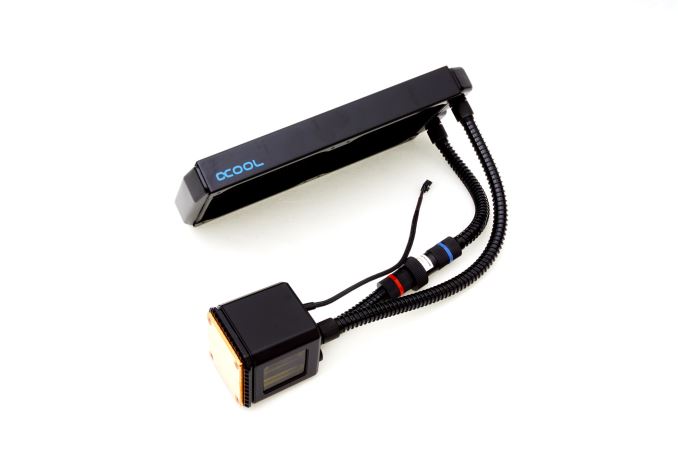
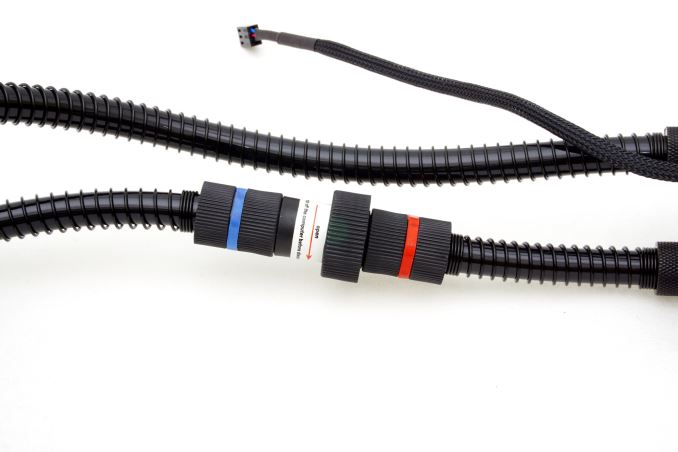
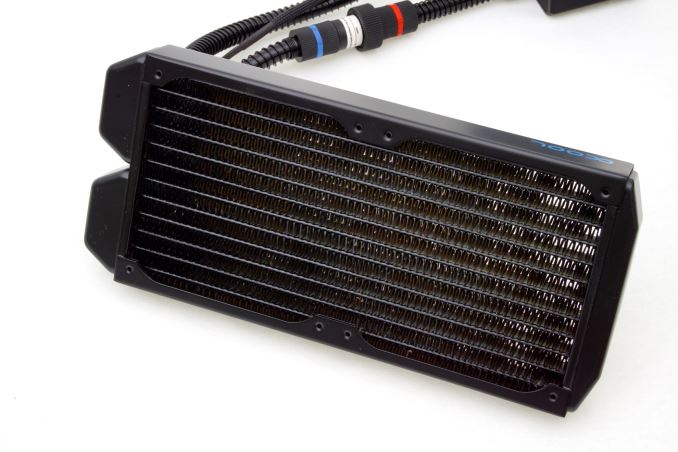
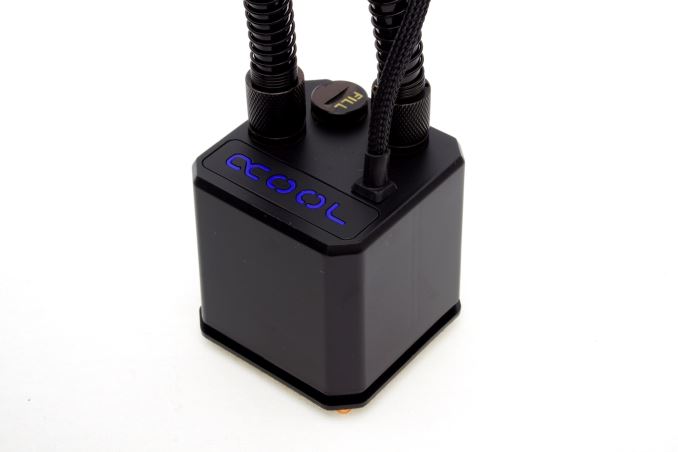
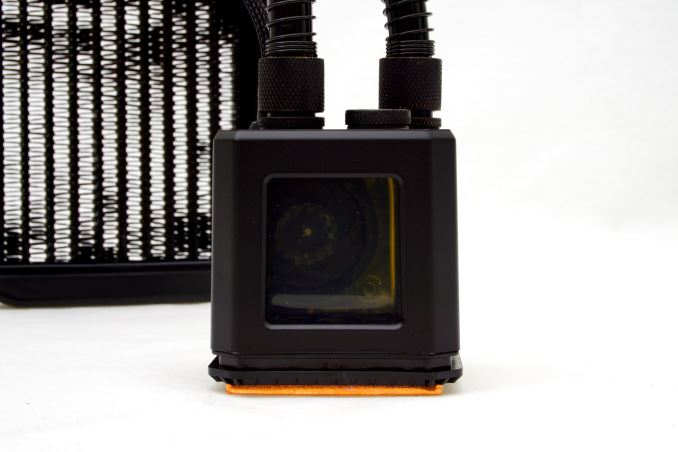









69 Comments
View All Comments
MobiusPizza - Monday, August 1, 2016 - link
The author says this cooler has best noise/thermal performance ratio, but looking at the graphs the CoolerMaster H110 seems to have both lower noise level and lower thermal resistance?retrospooty - Monday, August 1, 2016 - link
Yeah, I am really not getting the need for water cooling these days. Today's Core i5/i7 CPU run extremely cool... Even if you are overclocking, there are little to no benefits of using water. It adds complexity with no benefit. I have a Core i5 Skylake with a BeQuiet shadow rock 2 cooler, and I dont even plug in the fan at all. I can run prime - 100% CPU utilization for hours and hours with no fan at all and it doesn't even get warm, not even a little... and I live in Arizona and its summer. There just isnt a need for water anymore, even if you are overclocking the hell out of it.nightbringer57 - Monday, August 1, 2016 - link
Think about people still rocking a good old FX8350 like me ;)And AIO watercooling still happens to be competitive in high perf / small cases (typically mini ITX) setups, where clearance around the CPU is often very limited (typically, the PSU is in the way and forbids anything but very low-profile coolers), but can fit 1 or 2 12cm fans.
retrospooty - Monday, August 1, 2016 - link
Agreed, if you have an AMD CPU, you can benefit from water cooling. Some high end video cards as well... but AMD CPU's and high end video cards get hot as hell. My comment was on Intel CPU's. I would have a hard time recommending anyone buy an AMD CPU these days, regardless of the cooling used. Hopefully the upcoming Zen processor changes that. It would be great to go AMD again if they can be competitive.nightbringer57 - Monday, August 1, 2016 - link
edit: and Intel power consumption climbs up if you get into the more high-end platforms (like the X79/X99 platforms). Especially on tinier mainboards (think: mini ITX X99 ones) where you don't have standard cooler mounting holes but the special I-can't-remember-the-name ones. In those cases, big coolers don't fit. But a waterblock happily does.retrospooty - Monday, August 1, 2016 - link
I dont know... My core i5 6600k cooled as described above is a Mini itx case. Even if it were a smaller case, with no room for a huge tall cooler, there are options that work great.nightbringer57 - Monday, August 1, 2016 - link
It depends on your case.And as explained, your i5 is not realy an "enthusiast" CPU, even if it's a great CPU in itself.
And the options that work great in more confined cases... Do not work quite as great as your typical AIO watercooling system, even if those have difficulties getting significantly better results than average-to-high-end aircooling systems.
It's a niche, yes. But I wouldn't say this niche doesn't exist.
retrospooty - Monday, August 1, 2016 - link
Agreed, in some cases water would be better, AIO cases is a good example... But if you buy an AIO with water cooling, it comes pre-built and you dont do anything with it... The product above would not be for that. Also, if you have an older system you want to keep and improve the old air cooler, it might be good too depending on what you have... I guess what I am getting at, is if you were putting together a new system as of today (as opposed to upgrading an older one) you would be better served to by a case and an air cooler. They have tons of options of all sizes. Let me put it another way, if were building a new system as of today and you chose parts (case and CPU) that would benefit from water cooling, you probably chose badly.nightbringer57 - Monday, August 1, 2016 - link
When I say "AIO", I mean "AIO liquid cooler" (such as in this review), not "AIO computer" ;)And no, cases that cannot fit a good air rad (so limit the choice to either low profile rads or AIO liquid cooler) simply allow you to have a more compact PC, so they are not a bad choice, they answer different needs.
retrospooty - Monday, August 1, 2016 - link
Got it... I am paying attention LOL ;) I do see your point, I just dont think alot of people have that need. Like I said, if today (and that today part is a key thing here) were building a system, I cant see picking any case and CPU that would require something like the product above. If you are into massive overclocking, a tiny mini ITX case that cant fit a normal size air cooler probably isnt the best choice. There are plenty of mini ITX cases that can fit air coolers of any size and need. If you are overclocking and need something really small that cant fit a full size air cooler, OK... But if that is the case someone chose, where would they put the radiator? I know there are answers to that question and ways to do it, but extreme niche is what I am hearing.